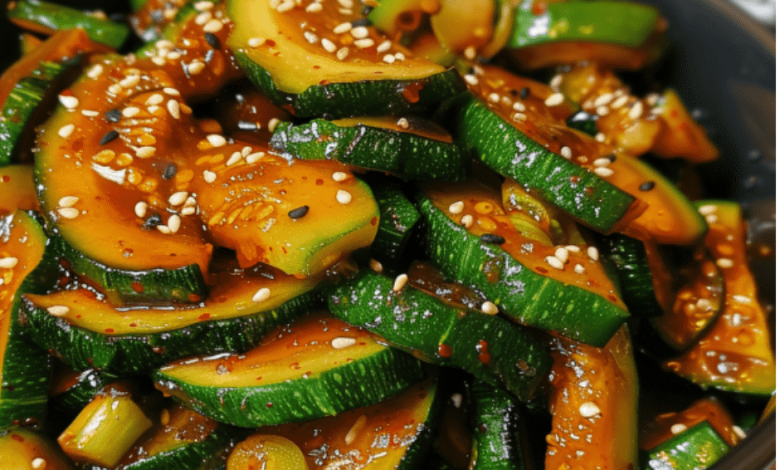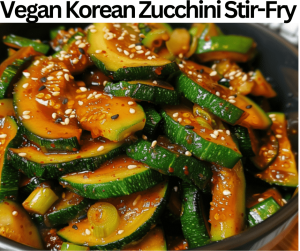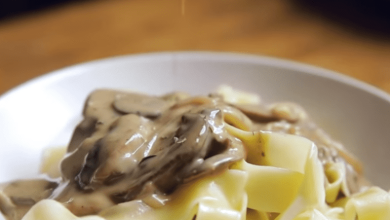Vegan Recipes
Korean Zucchini Stir-Fry


Vegan Korean Zucchini Stir-Fry is a quick, flavorful side dish born from Korean home cooking. Within Korean cuisine, it is frequently prepared as a “banchan,” the term for the small serving dishes that accompany each meal. The dish relies on tender slices of zucchini, aromatic garlic, flavorful green onion, and a splash of sesame oil for a luxurious taste. A splash of soy sauce lends a salty edge, and the sesame seeds contribute a nutty crunch. This vegan Korean zucchini stir-fry complements rice or noodles, and it also makes a tasty addition to a larger spread of sides.
STATS
- Diet: Vegan, gluten-free option
- Course: Side dish
- Prep time: 10 minutes
- Cuisine: Korean
- Cooking time: 5 minutes
- Serving size: ½ cup
- Yield: 4 servings
- Difficulty: Easy
- Total time: 15 minutes
- Cooking method: Stir-fry
EQUIPMENT
- Cutting board
- Sharp knife
- Non-stick skillet/wok
- Wooden spoon/spatula
- Small bowl
INGREDIENTS
- Slice two medium zucchinis thinly into half-moons.
- One tablespoon of soy sauce (or, if gluten-free, tamari)
- A teaspoon of sesame oil
- Two minced garlic cloves
- Two sliced green onions
- One spoonful of sesame seeds
- A teaspoon of vegetable oil
- Season with salt and black pepper
INGREDIENT NOTES
Zucchini:
- Delicately tender, with a subtle flavor. It cooks quickly and readily takes on seasoning. Slicing the zucchini into thin strips helps with even cooking.
Soy sauce:
- Soy sauce adds spicy zest and spicy richness. A suitable gluten-free alternative is tamari. If you prefer less sodium, use a reduced-salt version, which still gives plenty of flavor without being overpowering.
Sesame oil:
- A rich, nutty taste that is common in Korean cooking. A small amount has a big impact. High heat can dull its flavor, so always add it at the end of cooking to maintain its aroma.
Garlic:
- Lends a pronounced aroma and flavor. For best results, use fresh. Garlic not only deepens flavor but also gives natural health benefits.
Green onions:
- Add freshness, with just a gentle onion flavor. Reserve them for the finish, where their lively flavor will shine. They also give a splash of color, which makes the dish look brighter.
Sesame seeds:
- Toasting adds crunch and enhances their nutty flavor. They also bring visual appeal, giving the stir-fry a finishing touch.
Vegetable oil:
- Used for stir-frying. Prevents zucchini from sticking and burning. In order to avoid competing with the sesame flavor, a neutral oil works best.
Salt plus black pepper:
- Add salt and black pepper to taste. Remember that soy sauce has salt in it already. Use pepper for balance without overwhelming the zucchini.
INSTRUCTIONS
- Wash the zucchini & cut them into small/thin half-moons.
- In a skillet or wok, heat the vegetable oil over medium heat.
- Cook the garlic for 20 seconds until fragrant.
- Add slices of zucchini. Stir-fry until soft but not mushy, 3 to 4 minutes.
- Taste with salt, pepper, sesame oil & soy sauce.
- Stir well to coat evenly.
- Add sliced green onions and stir.
- Cook for a further 30 seconds. Before serving, top with sesame seeds.
TIPS
- Cut the zucchini thinly for a quicker cooking time.
- Heat sesame seeds in a pan over medium heat, swirling regularly, to bring out more flavor.
- For a touch of spiciness, add a tiny pinch of red pepper flakes.
- Pair it with rice, tofu, or kimchi for a complete meal.
STORAGE INFORMATION
Fridge:
- Keep it for at least three days in a sealed jar. Warm in a pan for the best texture.
Freezer:
- Not advised. After thawing, the zucchini becomes watery.
FAQS
Can I substitute other vegetables?
- Yes. Yellow squash or mushrooms pair well with zucchini. Bell peppers or carrots also add color and sweetness.
Do you consume it cold or hot?
- You can serve it hot or cold. Koreans often enjoy it at room temperature.
Can I make this oil-free?
- Yes. Substitute the oil with water for stir-frying. The flavor will be lighter.
Does this dish have a spicy kick?
- No. Gochugaru, or Korean chili flakes, can be added for spiciness, though. Another option is a drizzle of gochujang sauce for more heat and a touch of sweetness.
Is this dish filling enough to serve alone?
- It is best as a side, but you can turn it into a light main meal by adding rice, noodles, or baked tofu on the side.
NUTRITIONAL INFORMATION
Calories: 70
Protein: 2 g
Carbohydrates: 6 g
Dietary Fiber: 2 g
Fat: 4 g
Vitamin A: 8% DV
Vitamin C: 20% DV
Calcium: 4% DV
Iron: 3% DV




